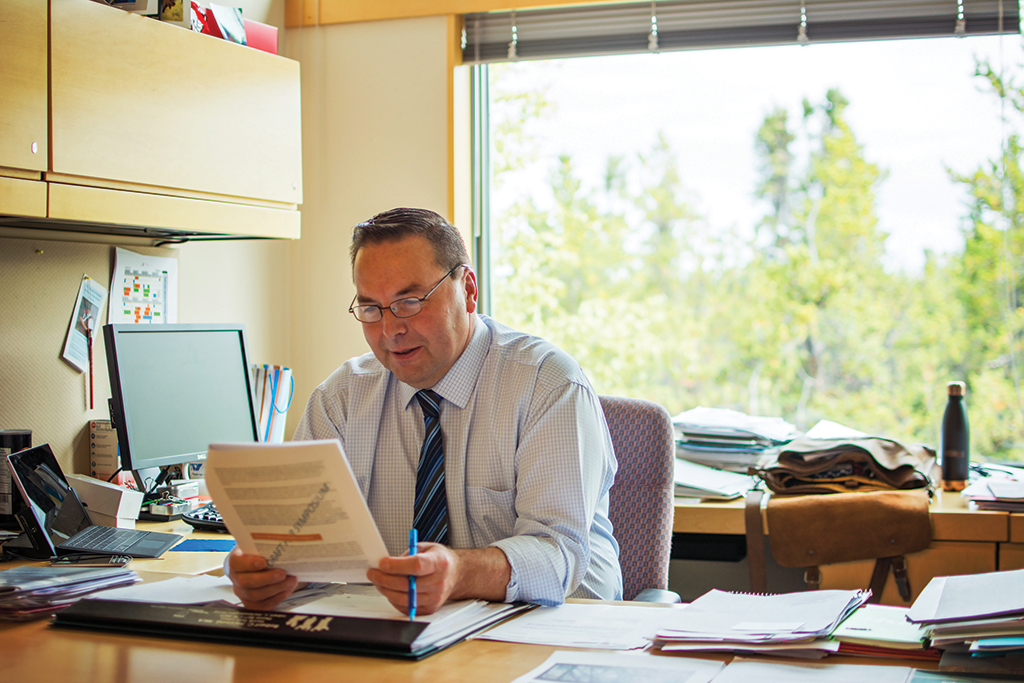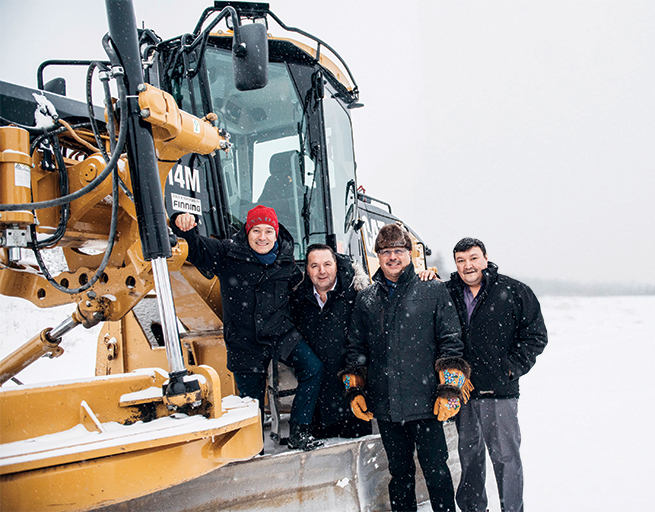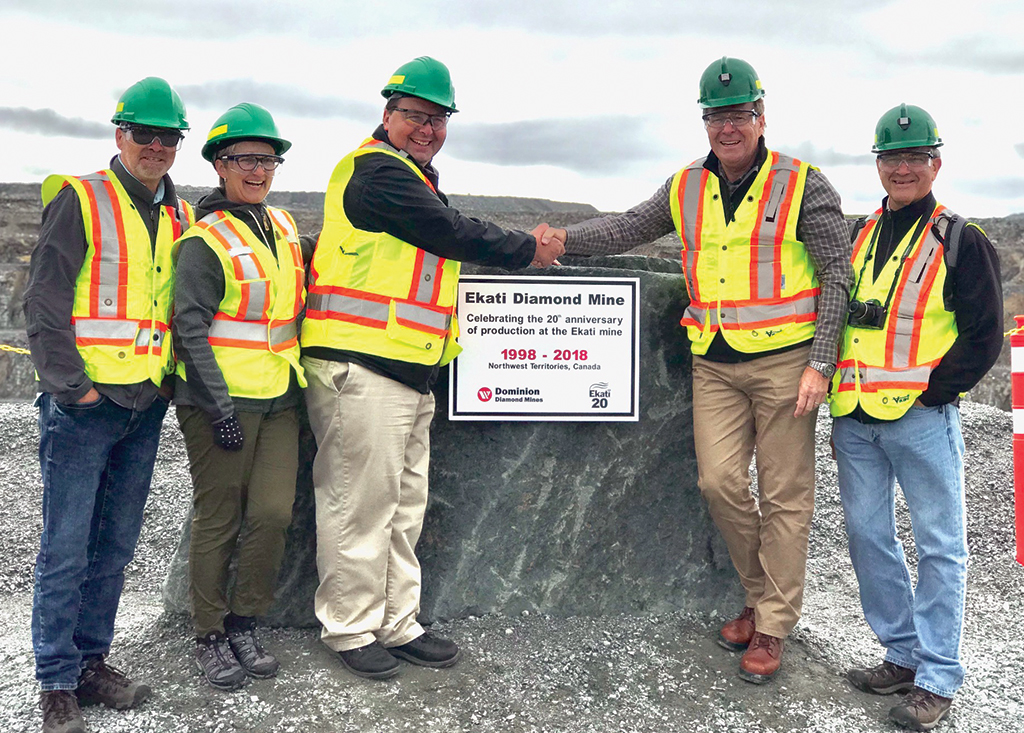
ONE ON ONE WITH
Wally Schumann
ABQ Chats with the NWT’s Minister of Industry, Tourism and Investment and Minister of Infrastructure
By John Curran
When it comes to monetizing resources in the NWT, the buck really does stop with Wally Schumann, perhaps doubly so.
As the NWT’s Minister of Industry, Tourism and Investment and its Minister of Infrastructure not only is it his charge to get people and businesses investing in the territory’s resources, he’s also the guy when it comes to channeling good government intentions into tangible assets that make it easier and more affordable for resource companies to do business here.
Aboriginal Business Quarterly recently went one-on-one with Minister Schumann to get his thoughts on the state of things in terms of both renewable and non-renewable resources in the NWT and the industries that depend on them.

ABQ: How would you grade the territory’s current ability to maximize the renewable and non-renewable resources it has available in its backyard versus how the NWT has done historically? What’s changed?
Minister Schumann: I think we’ve come a long way as far as encouraging economic diversity. For example, we’ve succeeded in building a globally-relevant tourism industry that’s using our spectacular sights to provide jobs and entrepreneurship opportunities for people. We now have a vibrant community of filmmakers making waves on the world scene which is really encouraging to see. There’s no denying our resource industries are not where they need to be right now, but we still have world-class potential that we’re working to harness and the GNWT is doing what we can to help that potential reach market. The industry recognizes this, which is why we moved up in the Fraser Institute’s rankings this past year.
ABQ: In terms of diamond mining, what is the department’s assumption about the industry’s long-term future in the NWT? Are you working with the idea that territory’s diamond mines will be all but gone in the next 15-20 years; or, that the existing mines, much like the gold mines that operated in Yellowknife for decades, will have the opportunity to discover and develop adjacent deposits potentially extending their economic lives well into the future?
Minister Schumann: While we’ve heard a lot of promising exploration news out of our existing mines, we need to do what we can to get responsible exploration humming across the territory so that we’re going to have new mines. My message throughout this term has been that we’re in a tough spot that deserves action, which is why we’ve taken action ourselves by doubling our incentives for grassroots explorers, working on mining legislation made by us and for our unique circumstances, and aggressively marketing our potential across the globe. It’s also worth mentioning that there are a lot of exciting metal projects moving forward – Pine Point, Fortune Minerals’ NICO project, an innovative small-scale push at Nehchalacho, and some very positive gold results in Yellowknife and the Sahtu – just to name a few.
ABQ: Obviously developing new infrastructure that lowers operating costs is one way to help ensure the NWT resource sector is more competitive; there by extending the lives of existing mines, making known deposits more economical to develop, and encouraging more exploration to find the next world-class deposit. The GNWT seems to be involved in three major highway building initiatives these days: the Mackenzie Valley Highway, the Tlicho All-Season Road, and the Slave Geologic Province Corridor. Are there any others you think we’ve missed? Can you please give a very brief status update on each one you’re engaged in?
Minister Schumann: Yes, these are the three main strategic transportation corridor initiatives that the GNWT is currently working on. In 2015, after considerable consultation with residents and communities across the NWT, the GNWT released its 25 Year Transportation Strategy, Connecting Us. These transportation corridors were identified in that document as being priorities for investment through that consultation process. The 18th Legislative Assembly also identified these three corridors as being priorities in their mandate. All three will provide increased access for exploration and development of natural resources, in addition to providing other benefits such as improving connections to communities and addressing impacts of climate change on our winter road system.
Here’s a bit of an overview on each of them:
The Tłı˛cho˛ All-season Road is the most advanced of these projects. It will provide all-weather access from Highway 3 west of Yellowknife to the community of Whatì. The GNWT is currently working with the Tlicho government to advance this project and construction is expected to begin in fall 2020. The Mackenzie Valley Highway will connect remote communities in the Northwest Territories to the Canadian highway system. Next steps for the project include engaging with Indigenous governments, NWT residents, and other stakeholders, and completing studies needed to proceed with the environmental assessment of this project.
And finally, the Slave Geological Province Corridor will support road access, hydro transmission lines and communications infrastructure into areas of significant mineral potential. Next steps include engaging with Indigenous governments, NWT residents, other stakeholders, and further planning. The Department of Infrastructure keeps up-to-date information on each of these projects on their website if individuals would like to stay updated.
ABQ: The GNWT recently put its Tungsten mine on the market. What market conditions have changed that made this the right time to look at selling? Can you also provide any further update on that process?

Minister Schumann: I should say first that it’s both the GNWT and the federal government who have a stake in this. The GNWT acquired the Mactung Tungsten exploration site in 2015 as part of the insolvency proceedings of North American Tungsten Limited. During this process, Canada accepted back responsibility for the Cantung mine as a New Site Requiring Remediation under the Devolution Agreement. Tungsten prices have improved significantly since 2015, generating interest from potential buyers. This is one of the reasons we’re taking action now and why together, the GNWT and Canada are working to sell them as a package. We are looking to get the best deal for NWT residents. In our view, that means not settling for a cash payout, but pushing for the possibility of bringing back the jobs and prosperity that left our territory when that mine stopped operating. That future is made more possible by packaging a big tungsten deposit and a mine with its own resources and infrastructure. Basically, with the right buyer, it wouldn’t take a whole lot to open this mine back up.
ABQ: In terms of renewable resources, the commercial fishing sector has received a lot of attention from this government. What does it mean for the industry’s future and the Town of Hay River to finally have a federal commitment for funding to build a new fish plant? What is the current status of the new plant?
Minister Schumann: This is an initiative our government has been pushing for a long time and it will be great for our local economy. Beyond the spin-off benefits, like jobs and local spending that will result from the fish plant build itself, our fishers are now going to have a cutting-edge facility to get the most for their catch and access to markets that they do not have today. We’re still in the planning stage and looking for the right people to do the job, but I’m looking forward to seeing this initiative progress.

ABQ: Tourism is another renewable resource-based industry that this government has championed a great deal. How successful do you feel the GNWT has been at encouraging tourists to come here? And how would you rate your department’s ability to support the resident operators’ in terms of product diversification and new venture development? Are there any individual tourism-related success stories you’re particularly proud of as Minister?
Minister Schumann: I think the numbers speak for themselves on this one. We’ve got leisure spending which has risen by about 75% over five years, an industry now worth more than $203 million when five years ago it was worth less than $140 million, and we’ve got 25% more operators operating than there were over the same time. So I would say we’ve done really well. That’s not to say there’s not still room for improvement – we’re always looking critically at where we can improve and listening to our operators and visitors to target our efforts to support the sector, but I am happy with the progress we have made so far. As for an individual success story, I’d point to our tourism business-owners who are accessing our mentorship programs. By utilizing these programs, businesses are seeing measurable improvements and that’s exactly the kind of thing we need to be doing as a government – supporting entrepreneurs.
ABQ: In terms of department priorities, what mix of renewable and non-renewable resources is the ideal target for the NWT’s future? What do you think it will take to achieve those goals moving forward?
Minister Schumann: I think it’s safe to say that for the foreseeable future, non-renewable resources are going to be the foundation of our economy, which can be a really good thing for industries across-the-board. Strengthening that foundation will create more investment which will make its way to local businesses, creating more opportunities for people living in our communities. As a territory, we’re going to need to keep addressing our biggest priorities to get there, including the infrastructure deficit, getting exploration moving, and investing in sectors like tourism, film, commercial fishing, agriculture, and manufacturing. We have strategies in place to guide those efforts, and I’m quite confident we’ll deliver.
ABQ: Are there any other resource-based initiatives – either renewable or non-renewable – that ITI currently has in the works that you think our readers would be interested in hearing about?
Minister Schumann: There were changes to our Diamond Policy Framework that may be of interest to your readers. The policy now provides the opportunity for manufacturers to export a portion of their NWT rough diamonds to lower cost manufacturing centres in exchange for alternative investments in other sectors of our local economy. Previously, manufacturers were required to manufacture all diamonds purchased under agreements with NWT diamond producers in the NWT. With this new policy, manufacturers will need to demonstrate proven investment in other areas of the economy such as jewellery manufacturing, retail outlets, and tourism partnerships. Their level of investment in the NWT is assessed to calculate an export provision so that they are not required to polish all rough diamonds that they receive from our mines here in the territory. I believe this is an innovative change and it’s getting a lot of attention internationally. I’m hoping to see some really interesting things coming out of the local diamond polishing industry in the future. ABQ

